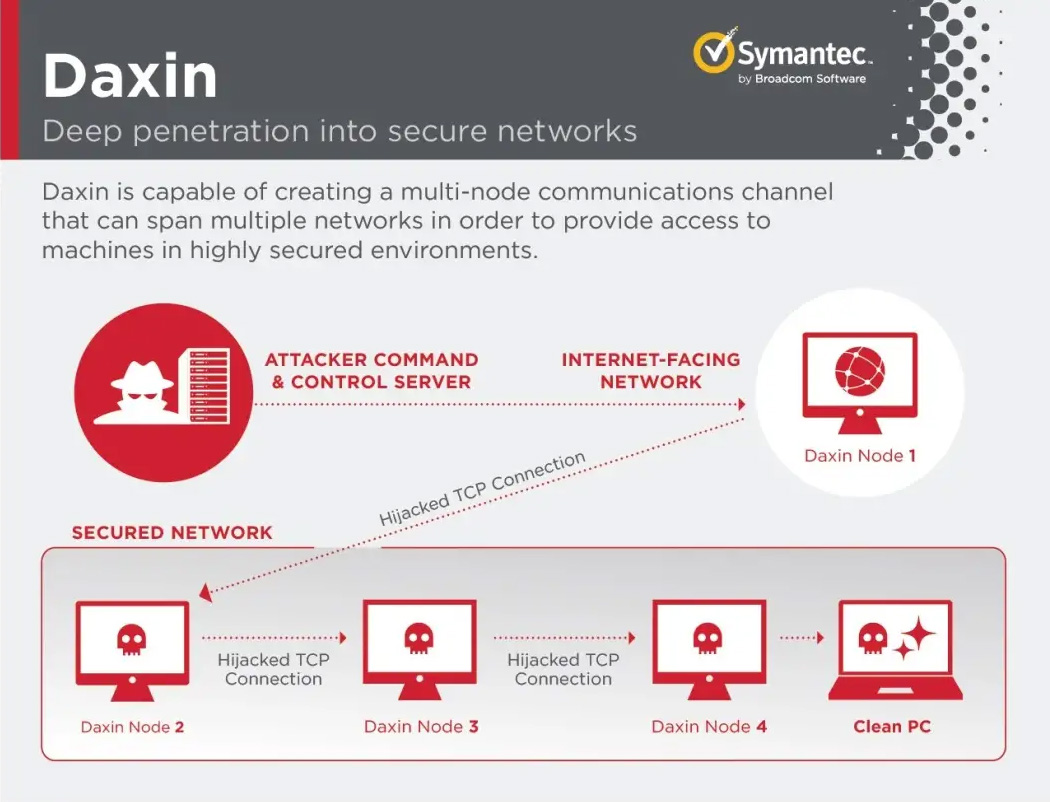News
Symantec Discovers Highly Sophisticated Chinese Hacking Tool
In its research report, Symantec calls the tool Daxin and describes it as the most advanced piece of malware researchers have seen.

In August 2021, the Cybersecurity and Infrastructure Security Agency (CISA) established the Joint Cyber Defense Collaborative (JCDC), a public-private cybersecurity information sharing partnership whose purpose is to unify defensive actions and drive down risk in advance of cyber incidents occurring. Now, one JCDC member, American cybersecurity software company Symantec, has discovered a never-before-seen hacking tool that has been successfully hiding for over a decade.
In its research report, Symantec calls the tool Daxin and describes it as the most advanced piece of malware Symantec researchers have seen.
Based on instances where components of the tool were combined with known Chinese hacking infrastructure, it’s almost certain that Daxin has originated from China. What’s more, the computers on which Daxin was discovered were also infected with other tools Chinese espionage actors are known to use.

“The malware appears to be used in a long-running espionage campaign against select governments and other critical infrastructure targets” explains Symantec’s Treat Hunter Team. “Most of the targets appear to be organizations and governments of strategic interest to China”.
Daxin allows attackers to perform various communications and data-gathering operations, and it appears to be optimized to perform especially well against hardened targets that can withstand less sophisticated attacks.
Also Read: How To Change Your Wi-Fi Password To Keep Intruders At Bay
“Daxin can be controlled from anywhere in the world once a computer is actually infected” said Vikram Thakur, a technical director with Symantec. “That’s what raises the bar from malware that we see coming out of groups operating from China”.
Since the initial discovery of Daxin, the U.S. government has shared the information with foreign partners to collectively stop the tool from spreading from country to country and from network to network.
So far, no organization in the United States has been infected by Daxin, but previous experience with malware like NotPetya, which was created by Russia to attack Ukrainian infrastructure, tells us that heightened caution is appropriate.
News
Mamo Completes $3.4M Funding Round To Enhance Fintech Services
The startup will use the influx of cash to expand into Saudi Arabia and across the wider GCC while improving its product offering.

UAE-based fintech Mamo has announced the completion of a $3.4 million funding round that will help the startup extend its market presence and improve its product offering. Investors included 4DX Ventures, the Dubai Future District Fund and Cyfr Capital.
Mamo’s platform offers “payment collection, corporate cards and expense management” to help small and medium-sized businesses consolidate and streamline their operations. With the latest influx of capital, Mamo will further develop its comprehensive suite of services and begin testing its product lines in Saudi Arabia, further extending its footprint across the GCC.
Imad Gharazeddine, co-founder and CEO of Mamo, stated: “We’ve been in the market for a while now and are incredibly proud of what our team has achieved. The holistic and expansive nature of our product offering has helped us continue to grow sustainably. This additional funding will allow us to reach our medium-term goals even faster. The support from new and existing investors is a testament to our strong expertise and the ability to deliver on our customer promise”.
Daniel Marlo, General Partner of lead investor 4DX Ventures, added: “We have immense trust in Imad’s vision, leadership and Mamo’s innovative approach to provide a user-friendly and comprehensive financial solution for SMEs that makes financial management more accessible and efficient. We are proud to partner with them and support their mission”.
Also Read: A Guide To Digital Payment Methods In The Middle East
Amer Fatayer, Managing Director of Dubai Future District Fund’s investment team, also commented: “Mamo’s localized product lines serve as an infrastructure for SME payments and spend management in UAE, a segment that is underserved by the country’s current banking infrastructure. The team has taken a product-first approach to consolidating SMEs’ financial journeys and building a fintech solution deeply embedded in a business’s core operations”.
To date, Mamo has raised around $13 million in investment funding and now boasts a team of 30 people. The company’s intuitive financial services platform has allowed over 1,000 businesses to consolidate their financial operations and significantly reduce payment fees.
-

 News4 weeks ago
News4 weeks agoAmazon Prime Day 2024: Get Ready For 6 Days Of Amazing Deals
-

 News4 weeks ago
News4 weeks agoSamsung Unpacked 2024: What To Expect From The July 10 Event
-

 News4 weeks ago
News4 weeks agoCoursera Report Shows Surge In UAE Interest In AI Upskilling
-

 News4 weeks ago
News4 weeks agoMeet Dubai’s Groundbreaking Smart Robot Delivery Assistant
















